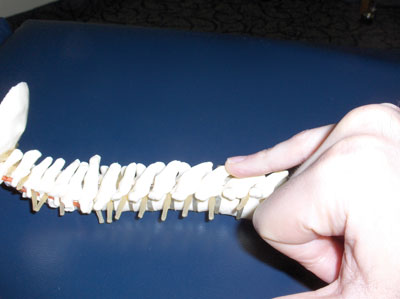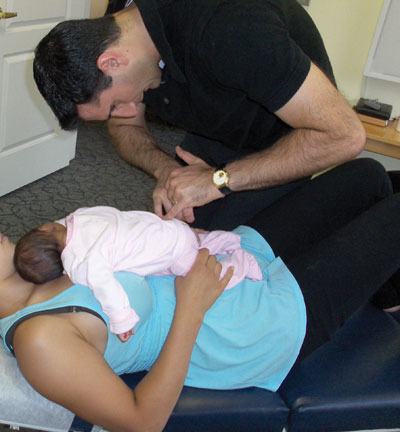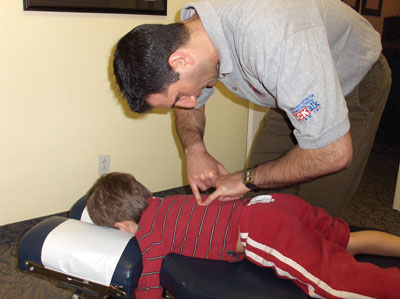
Technique Toolbox: The Safety of Chiropractic Pediatrics
By John Minardi BHK DC
Features Clinical TechniquesSample Case: A 25-year-old female presents to the office with her three-month-old daughter.
SAMPLE CASE
A 25-year-old female presents to the office with her three-month-old daughter. The mother relays to the doctor that a friend recommended she bring her daughter to the chiropractor for a checkup. The friend suggested this might verify any misalignments that may exist in her child’s spine following a difficult delivery.
The mother goes on to state that she went through a painful labour that lasted 15 hours, followed by a complicated delivery. She explains that her daughter was not in a normal position at time of delivery, and the medical professionals assisting with the delivery needed to manipulate her daughter’s position to allow a natural birth to occur. The mother had insisted that she preferred that to a caesarean section being performed.
The mother is adamant that she sees nothing abnormal with her child, nor does her daughter exhibit any symptoms. However, since delivery, she has been worried that something may be wrong with her daughter, as a result of such a traumatic event. Her friend, who is a longtime chiropractic patient, suggested that her daughter be checked, so the mother decided to bring the child in for a chiropractic assessment.
Examination reveals a vibrant and happy child upon observation. Physical examination reveals subluxations present at T1 and T4, discovered with both static and motion palpation. These subluxation findings are exaggerated by the fact that the child shifts and squirms each time the doctor palpates the subluxated areas. All neurological and remaining pediatric tests were unremarkable.
During the report of findings, the doctor explains the child’s assessment to the mother. The mother asks the doctor if it is safe to adjust a child. The doctor reassures the mother that chiropractic care is very safe for the infant, and that all adjustments for children are extremely gentle. The doctor also emphasizes the importance of adjusting the subluxations now, to prevent future problems, rather than allowing the issues to persist until symptoms appear.
Has this situation ever presented to you? Have you ever assessed a child, found that subluxations were present, but were asked if chiropractic care is safe for children? Would you be confident relaying to a parent that adjustments for a child are indeed safe, as well as necessary, when subluxations are present? In this edition of Technique Toolbox, I will address these questions, and review a safe and effective thoracic adjustment for a pediatric patient.
THE SAFETY OF CHIROPRACTIC CARE FOR CHILDREN
Many chiropractors are hesitant to adjust children. Much of this hesitation is due to the inadequate training that was provided to them. Others are hesitant due to fear of hurting the child, and still others simply do not know where to begin, or how to adjust a pediatric patient.
Unfortunately, certain individuals have tried to cast a negative light on chiropractic care for pediatrics. A 2007 article in The Paedatrics Journal1 stated that spinal manipulation caused adverse reactions in 13 of the 14 cases studied. However, as pointed out by the World Chiropractic Alliance, those cases were culled out of approximately 14,000 published articles, and specifically excluded studies where no adverse effects were reported. Dr. Terry Rondberg stated, “Obviously, the researchers were looking for extremely rare cases of spinal manipulation causing injury”.2 The researchers admitted that their “study had several limitations” and acknowledged “serious adverse effects may be rare”.2 A more current study3 indicates that chiropractic care has a positive effect on the pediatric population. The research indicates a high rate of improvement with respect to the children’s presenting complaints, in addition to salutary effects unrelated to the children’s initial presentation.3 The literature suggests that chiropractic care is safe and effective, and that the chance of adverse effects is extremely rare.
So, now that we are comfortable with the safety of chiropractic for kids, how do we assess and correct for a pediatric thoracic subluxation such as that seen in our sample case?
 |
|
| Photo 1: Static and motion palpation contacts are displayed on a pediatric skeletal model. Note that a pinkie contact is on the posterior aspect of the thoracic spinous processes, applying P-A palpation. | |
 |
|
| Photo 2: Sustained pressure adjustment is displayed for an infant. Note how the infant can be placed comfortably within the mother’s arms and chest for maximum pediatric patient compliance. | |
 |
|
| Photo 3: Sustained pressure adjustment is displayed for a toddler. Note that no thrust is delivered by the doctor. Instead it is a sustained 4-6 ounces of pressure applied for 20-30 seconds in the line of correction.
|
Analysis: (See Photo 1)
Step 1 Static Palpation:
Patient: Lying prone on mother’s chest.
Doctor: Either side of table.
Procedure: Use a pinky contact to palpate the posterior aspect of each spinous process of the thoracic spine.
Step 2 Motion Palpation:
Patient: Lying prone on mother’s chest.
Doctor: Either side of table.
Procedure: Doctor stabilizes the infant’s forehead, and gently flexes and extends the head and neck, while simultaneously applying P-A palpation to the thoracic spinous processes.
Results:
Normal: When the infant is subluxation-free, both static and motion palpation should have a soft and spongy end feel (similar to walking on a sandy beach).
Subluxation present: When a subluxation is present in the thoracic spine, an abrupt and hard end feel is present (similar to walking on a sandy beach, and stepping onto a seashell). Also, as in our sample case, the patient may squirm or become uncomfortable when palpating the affected area, further confirming the presence of subluxations.
Adjustment
Sustained Contact Thoracic Correction (See Photos 2 and 3):
Patient: Lying prone on mother’s chest.
Doctor: Either side of table.
Contact: Pinky contact on the posterior aspect of the subluxated thoracic segment.
Stablilization: Opposite pinky stabilizing contact hand.
LOC: P-A, using a sustained contact pressure. The sustained pressure should be no more than four to six ounces, maintaining the pressure in the line of correction for 20 to 30 seconds. There is no thrust. Simply a gentle pressure is applied as the doctor feels the vertebrae slowly glide into position.
The doctor should note that a subluxation in an infant’s thoracic spine indicates that the vertebrae has subluxated posteriorly. There is very limited, if any, rotation at this age, and thus, the line of correction changes focus from posterior to anterior. Immediately following the adjustment, the abrupt end feel should be decreased significantly, and the soft end feel should return.
As usual, I have only scratched the surface as far as pediatric adjusting is concerned. In order to better serve and safely meet the needs of this unique population, each of us require additional postgraduate training. If you would like to learn more about adjusting children, go to www.icpa4kids.com. If you have any questions, e-mail me at johnminardi@hotmail.com.
Until next time . . . Adjust with confidence! •
REFERENCES
- Vorha, S. et al. Adverse effects associated with pediatric spinal manipulation: a systematic review. Pediatrics. 2007. 119(1):275-283.
- http://www.worldchiropracticalliance.org/media/pediatricjournal.htm
- Alcantara, J. et al. The safety and effectiveness of pediatric chiropractic: A survey of chiropractors and parents in a practice based research network. Explore. 2009. 5(5):290-295.
Dr. John Minardi is a 2001 graduate of Canadian Memorial Chiropractic
College. A Thompson-certified practitioner and instructor, he is the
creator of the Thompson Technique Seminar Series and author of The
Complete Thompson Textbook – Minardi Integrated Systems. In addition to
his busy lecture schedule, Dr. Minardi operates a successful private
practice in Oakville, Ontario. E-mail: johnminardi@hotmail.com, or visit
www.ThompsonChiropracticTechnique.com.
Print this page